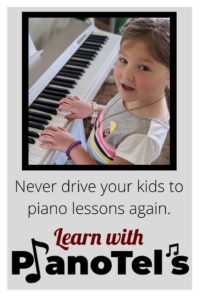The first 12 piano lessons are some of the most crucial times. This is where we start and develop healthy habits, where we cultivate that love of the instrument, where we build confidence, and where we introduce these students into the magical world of creating music. I am beginning a new set of students and I wanted to offer you my lesson plans that I use for beginning students.
I haven’t found just one method book for beginner students that really fits my style. I have combined the different methods that I have used over the years to create my own unique approach. That is what I am going to share with you in my 12 Lessons Plans.
I prefer you to use your own adaptations to fit your style, so please adapt and adjust as to what fits you and your student. Also, I like to do group lessons, but these lesson plans work for groups or individuals.
For a free printable version of this lesson plan click Lesson #1 Introduction_ Coming to Know Each Other and the Piano. For a free printable version of the homework for this lesson, click Lesson #1 Homework.
Lesson 1: Introduction – Getting to know each other and the piano
This first week is about getting to know the students. Some of them may be nervous about being there and that’s fine. Usually they are pretty excited to be there and can’t wait to tell you all about it. The idea is to get them comfortable with you and with each other, and for you to get to know them better. It also is a time for them to get to know the piano and to become comfortable with the piano.
Time Needed: 20 -30 mins
Audience: intended for elementary ages, can adapt to individual or class
Materials:
- Large floor staff (as is found here)
- Ledger lines to add to the staff
- Gold treasure (to act as a note)
Goals:
- Get to know the student – establishing a steady internal beat
- Familiarize with piano
- Staff recognition: lines/spaces & steps/skips
- Finger Numbers
Game: Get to know the student – establishing a steady internal beat: (5 mins)
Sitting in a circle, pat lap, clap, snap. Repeat.
In a rhythm of lap, clap, snap, introduce names on the “snap”.
Ask more get to know you questions and have them answer on the snap, in rhythm.
- What’s your favorite color? Food? Sport?
- Your favorite thing to do?
- Favorite vacation? Place to go?

Familiarize with piano: (5 mins)
Include one more time to lap, clap, snap, asking how old they are. Did they know that the piano is over 300 years old?!
Time to study the different parts of the piano — open up the lid.
- Look at what elements are in the piano. Notice the strings. Some people say that this is a stringed instrument because it has strings. BUT what happens when you press a key on the keyboard? What does a hammer hitting the strings make you think of? This action of the hammer hitting the strings classifies the piano as a percussion instrument!
- What happens when you hold a key? What happens when you press each pedal down and then hold a key?
Time to study the outsides of a piano.
- What do you notice about the keys?
- Can you play your hand on the set of two black keys? Then on the set of 3 white keys?
- Place your hands on the keys and make the sound go up. Make the sound go down.
Staff recognition: lines and spaces (5 mins)
While setting up your floor staff, tell the students that all musicians have a treasure map. This treasure map is tricky, but I know that all of the students can figure it out – that’s what piano lessons are all about. The treasure map shows us where every note on the piano lives. I am going to teach them how to use the treasure map.
- Have our treasure seekers step on each line on the staff. How many lines are there?
- Give the treasure seekers their first clue on this map: not only are their lines on this map, there are spaces! See if they can figure out where the spaces are. How many spaces are there?
- Ready for the next clue? This treasure map goes beyond the lines and spaces! It is definitely possible to go off the treasure map! Add in ledger lines. Practice walking up and down the staff with ledger lines.
Staff recognition: steps and skips (5 mins)
Place your gold treasure on the staff. Is it on a line or a space? Place a second treasure on the staff and explain that from one treasure to the next on our treasure map is a step. Give them “treasures” to create their own steps.
- Since we know we are using a treasure map for the piano, come over to the piano and place a treasure on middle c. What would be a step up from that? What would be a step down? What would be five steps up? Five steps down from there?
Back at the treasure map (the floor staff) Place a gold treasure on the staff. Is it on a line or a space? Place a second treasure on the staff and explain that from one treasure to the next on our treasure map is a skip. Give them “treasures” to create their own skips.
- Since we know we are using a treasure map for the piano, come over to the piano and place a treasure on middle c. What would be a skip up from that? What would be a skip down? What would be five skips up? Five skips down from there?
Finger Numbers (5 mins)
The last thing we need to learn is right on our very own bodies. You have 10 of them and they help you scratch, help you tie your shoes, help you eat your popcorn….what is it? Your fingers! Each of your fingers have a name. Hold your hands together with an imaginary bubble between. Explain that your fingers are like a spider sitting on a mirror. Have them play with their spider mirror – squishing their hands, lifting them wider — as long as the fingertips stay in contact with each other. This spider has 5 legs. While lifting each “spider’s leg” when you name it, demonstrate and say the finger number for each number, starting with your thumb as 1. Now, we are going to make the spider dance on it’s mirror. When you call out a number, have them lift that spider leg (their finger) high in the air. *Watch for good, rounded fingers.

- Complete worksheet
- Identify 5 steps and 5 skips on the piano
- Name each finger the appropriate number
Tel loves her life as a piano player, a piano teacher, and a mom. Amid piano blogging, piano teaching, and piano playing, she loves a chance to fit in a good exercise class, volunteer at her kids’ school and at her church, and go on long dates with her husband. Full bio at About Tel.



I was a college trained piano teacher 65 years ago. I played the piano and organ, and directed the children’s choir. I became an elementary school teacher, principal, and supervisor, so no time for teaching piano. I found your website looking to see what’s new in teaching, because my youngest g-granddaughter wants to learn. I like your approach, and lesson plans. Thanks for sharing!